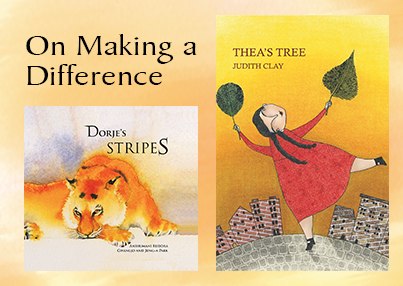On Making A Difference
The world seems to be in an overwhelming rut these days, from the daunting prospect of a climate breakdown to the scary spectres that these disasters seem to tell us will one day be reality. A world of concrete jungles, no water, and all the natural world under threat of extinction seems to await us just around the corner. Dealing with these specific ideas are two books – Dorje’s Stripes and Thea’s Tree. Both stories are about a singular act of change that can rectify the course of two separate but related disasters. What these stories have in common, is the idea that action, along with hope, can be the answer to some very overwhelming questions.

In Dorje’s Stripes, a tiger loses his markings as Bengal tigers are hunted and their numbers dwindle. At one point, Dorje the tiger is left with no markings on his body except for the two dark spots above his eyes – a symbol of how alone he is. One day, a mysterious stripe re-appears on his back, bringing with it the hope that maybe Dorje is not as alone as everyone thought he was.
Thea’s Tree is about a world with no trees and one girl’s hopeful act of planting a seed that saves it. It looks at the direct result of action and the breadth of impact actions can have – even if they come from a small child.
Both are tales of overwhelming hope in the face of acute hopelessness. This, in Dorje, is seen through how singularly lonesome the tiger is and in Thea by showing us a world without trees. Both Dorje and Thea are also stories that look into the sins of a previous generation and their rescue by a newer one.
Thea’s Mama and Papa have only stories from their childhood left to tell Thea on what trees are. This creates in her an intense longing for this lost entity and kickstarts her journey in the book. Hunting, poaching, and mankind’s selfish disregard for the tigers are the central themes in Dorje’s Stripes. Another way that both Dorje and Thea showcase hope is through the optimism of the characters. Hope as an antidote to the greed of humankind. Master Wu, the Buddhist monk, and the children of the monastery take good care of Dorje when he is at his weakest, rehabilitating him until he is ready to go back into the wild. In Thea’s case, her parents capture her imagination with wonderful stories about the trees from their childhood and later helps her grow her very own tree. These characters are a necessary counterpoint to the cruelty of man, letting readers know that not everyone feels or acts in the same way and that even in the bleakest of times, humanity can find people to depend on and have faith in.
Dorje’s Stripes and Thea’s Tree are also two necessary narratives on the importance of conservation. They show us two worlds that both feel a marked lack of something only to later reveal them as casualties of man’s carelessness. We also find in them a before and after in which the after feels that much fuller and happier because of hope. The after is a newer, gentler world, and one that is a better place for everyone in it.





